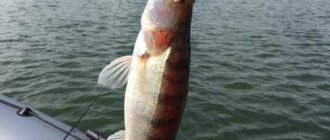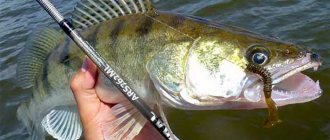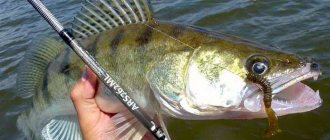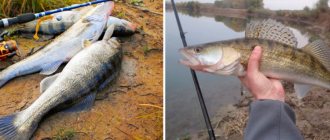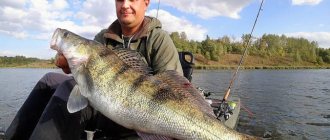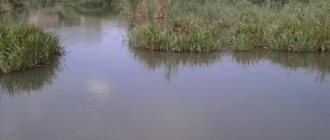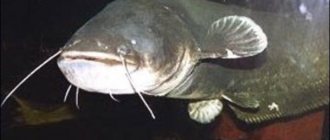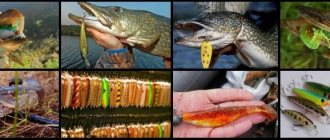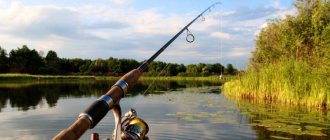Fishing for pike perch in the fall is considered the most productive and it is during this season that the largest, trophy specimens are often caught. Starting from mid-September, pike perch exhibits a pronounced increased appetite, and its activity increases significantly. At this time, spinning works great, and catching pike perch with a jig in the fall gives the best results. For pike perch fishing fanatics, there is night jig fishing for pike perch. Let's figure out what the technique of catching pike perch with a jig is and talk about the gear that is needed for this. Let's watch the video - night fishing for pike perch with a jig in the fall.
Jig fishing for pike perch
Catching pike perch in the fall will be more effective in search mode or from a boat, because pike perch at this time is actively moving across the vast territory of the reservoir, and the wait-and-see technique for catching pike perch is unlikely to bring the desired results.
The best bait for catching pike perch in the fall are various jig baits, this can be a vibrotail, twister, or foam fish. Various techniques are used for wiring, but the most effective is stepwise.
Where to catch pike perch in November
Favorite parking areas, and therefore places for catching pike perch in November, are rather deep areas of the reservoir. With the onset of November, pike perch begins to group into schools of several individuals and moves closer to their intended wintering areas. But the path to these places for pike perch can take considerable time.
Along the way, he can stop and linger for a while in places rich in food. In this way he restores lost strength. Therefore, if you find such a place, you can consider yourself lucky. From one place you can catch up to several weighty pike perch. But if the bite has stopped, then don’t be upset; come to the same place the next day, and you will be pleasantly surprised that the place rich in food will be occupied by another flock of November pike perch.
Fishing for pike perch in September
Autumn pike perch fishing usually begins in early September. In the first autumn days, you can safely go night fishing - night fishing for pike perch in the fall with a jig is always successful. It is at night, when there is no extraneous noise, that pike perch are caught on a jig head. Not every angler knows that it is at night that pike perch are great at jigging. Night fishing for pike perch with jigs in the fall is due to the fact that pike perch gradually begins to move to wintering areas - these are deep places in the reservoir where jigs are most relevant.
How to catch?
When we question how to catch pike perch using a spinning rod in the autumn, we mean coastal fishing and fishing from a boat. The choice of one method or another depends on the specific body of water. Naturally, if the fanged one can be reached from the shore, there is no need to use a swimming device and vice versa.
In both cases, it is advisable to visit the same places where summer fishing for fanged predators was successful. If this is your first time on a particular river, you can use information from local fishermen or those spinning enthusiasts who often visit places unfamiliar to you.
Photo 2. Catching pike perch from a boat.
Fishing for pike perch in October
Closer to October, before the onset of cold weather, pike perch becomes most active in searching for food. The time comes when he begins to have a long glutton. It lasts for about a month. Avid fishermen know that October is rich in trophy fish.
Of course, the October bite for pike perch is significantly different from the pre-spawning one, but if you find the location of the fish, then catching pike perch with a jig will bring the richest catch.. In search of food, any predatory fish grabs almost everything that moves in front of it, and pike perch is no exception to the rule. In addition to jig heads, pike perch also take baits such as foam fish or oscillating spinners well.
When to catch pike perch in November
The first November frosts indicate that it is time to go on the most productive fishing for pike perch. Fishing for pike perch in November has its own characteristics.
For example, if we consider the time of day when pike perch bites best, then this is, of course, night. Pike perch can rightfully be called a nocturnal predator. But this is not a dogma; in November, pike perch takes well almost any time. But still, it is necessary to note the two time periods of the day that are most successful for catching pike perch in November, these are the early morning and the evening before sunset.
Fishing for pike perch in November
By mid-November, the pike perch bite begins to slowly subside. And fishing for pike perch with jigs gradually ends in the fall, but in November there are also moments when, before the reservoir begins to become covered with ice (about a week), quite large specimens of pike perch are caught.
This is directly influenced by the following factors: atmospheric pressure, the presence of wind, precipitation and others. Fishermen who have little experience, having fished in October, cover their fishing rods before the onset of winter fishing or before spring fishing. And thus they miss their chance to catch a trophy pike perch by night fishing for pike perch in the fall with jigs.
Best time to fish
Pike perch is a nocturnal predator . In November, it changes the rules somewhat and is especially active in the morning and evening, before sunset. But this does not mean that daytime fishing will not bring good luck; there are exceptions to all rules. In November you can catch pike perch during the day.
If you have never caught pike perch using spinning trolling or jigging, now is the time to try it. Successful fishing for this predator in November is guaranteed if you remember a few wise tips from experienced fishermen:
- be responsible when choosing a spinning rod and its equipment;
- change bait;
- look for promising places;
- alternate wiring and playing.
Remember that in many reservoirs there are very large representatives of their genus, and the catfish will not refuse to eat, so choose gear that will withstand the serious weight of your trophy.
You can share your observations and stories about catching walleye in November in the comments below.
Night fishing for pike perch on a jig
For fans of pike perch fishing, fishing for pike perch at night with a jig in the fall will be a real adventure. The technique for fishing for pike perch at night is the same, and, as practice has shown, the coloring of a twister or vibrotail is not particularly important and various silicone “fireflies” do not perform better than ordinary ones.
Again, it all depends on the wiring technique you choose, proper execution, and of course the presence of pike perch in the given water area of the reservoir. For this reason, night fishing for pike perch in the fall requires careful preparation. It is necessary to choose a place for fishing in advance, since at night you can’t really walk around the reservoir and you can’t see any landmarks. A flashlight on a boat to mark it in the water area and a personal headlamp, as you yourself understand, are simply necessary things.
The light from a small lantern does not scare the pike perch at all. In addition to jig baits, take with you submersible wobblers. Night fishing for pike perch with jigs in the fall is possible both with jig baits and well-buried wobblers, and placing them in the bottom level can also give an excellent result.
Catching pike perch with mugs
On large and medium-sized rivers, pike perch are caught using mugs. The weather conditions in September allow comfortable fishing from a boat. Mugs for pike perch can be purchased at a specialized store or made yourself. Instead of classic circles, you can use other floating materials of various shapes: dense foam, plastic bottles, etc. The main thing is that the design allows laying the fishing line of the required length, and is provided with a latch, which, after biting, releases the fixed fishing line.
The rigging can be done as on a donk. It is not necessary to install a metal leash for insurance. Pike are usually absent from pike perch habitats. It is worth expecting that a catfish may also bite on the bait for pike perch.
It should be noted that pike perch fishing in September is highly effective, and many anglers are looking forward to the onset of autumn for targeted fishing. With the correct equipment and selection of different pike perch lures and baits, you can count on a positive result. A patient search for a predator usually ends with its bite.
Technique for catching pike perch with a jig
Let's now figure out what the technique of catching pike perch with a jig is and talk about the gear that is needed for this. When catching pike perch with a jig, the whole point is to move the bait along the bottom in steps. A front-loaded foam rubber fish is used as bait. The technique of catching pike perch with a jig in the fall implies that during the retrieve the bait must periodically rise and fall to the bottom. The posting continues until the bait reaches the boat or shore.
Let's simulate the situation so that you understand what the technique of catching pike perch with a jig in the fall is:
- You are in a boat on a river with a medium current. Below you is a flat bottom for the entire length of casting the jig, the depth is 4-5 meters. In a word - ideal conditions for catching pike perch with a jig. You are casting. When the jig touches the surface of the water, you close the line handle of the spinning reel. The tip of the spinning rod bends under the weight of the jig and the force of the water flow, and the jig begins to fall to the bottom.
- At the moment of the fall, a pike perch bite may already occur. This will either be a click on the jig, or a scratch, a gentle tug or a blow. As a rule, at this moment the bite is clearly felt. The hooking must follow immediately, for this you definitely need a braided fishing line. It instantly transmits the slightest touch to the jig and, due to its inextensibility, hooks the fish very quickly. If there was no bite at the time of the fall, the jig sinks to the bottom. The tip of the spinning rod is slightly straightened - only the force of the water flow acts on it.
- You make two slow turns with the reel handle. Your job is to slowly lift the jig off the bottom. As soon as you start to rotate the reel handle, the spinning rod will bend again, the jig will come off the bottom and will act on the spinning rod again. After completing the revolutions of the reel handle, you begin counting: one hundred one, one hundred two, one hundred three. The jig should fall to the bottom - the tip of the spinning rod will straighten slightly again. Relatively speaking, the jig follows some kind of trajectory near the bottom, reminiscent of a wave. Let's call this trajectory a step, and the wiring based on this step will be called stepped. To catch pike perch, you must master it and try to make your steps similar to those described above.
- I highlight the main point in the technique of catching pike perch with a jig - a pause after reeling - 2-3 seconds. Observing this condition, you try not to raise the jig high above the bottom with your wiring, because pike perch attacks about a meter from the bottom. Most bites occur precisely during the phase when the jig falls to the bottom after the reeling stops.
An ideal retrieve for pike perch when fishing with a jig should look like this: cast, the jig touches the surface of the water, the jig falls to the bottom with the line handler closed, the tip of the spinning rod bends and trembles slightly at the moment of the fall (if the spinning rod is of good quality, its tip shows that your bait is plays in the water).
Then the jig falls to the bottom, you make 1.5-2 turns with the reel handle, pause for 2-3 seconds. After the jig falls to the bottom, freeze for a second and start the step again. They should follow one after another, monotonous, similar to each other.
I understand that this is boring, you’re probably tired of just the description of the process, but otherwise you’ll catch pike perch by accident. Let me remind you that I am talking about autumn pike perch on the river. However, pike perch can take such a line at any time of the year, on any body of water.
Pike perch fishing technique
Hunting for pike perch in September is an exciting activity; for fishermen it is a real pleasure. Pike perch differs sharply in its behavior.
Unlike the predator pike, it is not in ambush among thick algae and does not wait for prey in a shelter.
At this time, he begins to eat, he is actively looking for prey. The pike perch chases any fish, driving it.
You can catch pike perch in September both during the day and at night, since this “river striped tiger” searches for prey in the fall at any time of the day.
But its aggressiveness is observed after sunset, then the pike perch rushes to the bait.
In terms of gluttony, pike perch is much superior to pike and is distinguished by its strength, speed, aggressiveness and tenacity. He does not leave his intended victim alone and chases him to the end.
What is the difference between the technique of catching pike perch with a jig? It differs in that the bait is passed along the bottom in a stepwise manner. A front-loaded fish made of foam rubber is used as bait.
During wiring, it is periodically raised and lowered to the bottom.
Here's what the situation looks like:
- The fisherman is in a boat on a river with a depth of 4-5 meters, the bottom of which is flat for the entire length of casting the bait, and the current is slow. The spinner makes a cast, after which the jig touches the surface of the water, and he closes the line handle of the spinning reel. The weight of the jig and the force of the river current cause the tip of the spinning rod to bend, and the jig rushes to the bottom.
- If there is a scratch or a weak click on the jig, as well as a slight jerk or blow, it means that the predator has already bitten during the fall. At this moment, you need to immediately make a hook. When using braided fishing line, the slightest touch is instantly transmitted to the jig, since such fishing line does not stretch and quickly hooks the pike perch. If there is no bite, the bait sinks to the bottom.
- The next stage of the operation will be a double turn of the reel handle, then the jig will slowly rise above the bottom. As soon as the reel handle begins to rotate, the rod will bend again, the jig will break off the bottom and begin to act on the equipment again. The rotation of the reel handle ends. In this case, the jig should fall to the bottom - the tip of the rod straightens again. Such a wave-like trajectory, developed by fishermen, is called a step, and wiring based on this step is called stepped.
- The main decisive point in the technique of catching pike perch with a jig is maintaining the required pause after reeling, which should be only 2-3 seconds. The attack of the pike perch on the bait should be expected at a depth of about one meter, so you should try not to raise the jig high above the bottom when retrieving it.
Most bites are usually observed when the jig falls to the bottom, when the reeling is stopped.
Tackle for catching pike perch with jig
An indispensable tackle when catching pike perch in the fall with a jig is a spinning rod. Its length is selected in the range from two to three meters. If you are fishing for pike perch from a boat, you can use shorter gear (up to two meters). For more obvious control over the behavior of the jig during retrieving, you need a fast-action spinning rod, that is, one in which the upper third of the blank bends under load.
It is better to choose a fishing line for autumn fishing for pike perch with a jig in the range from 0.14 to 0.2. Braid is ideal as it has a much lower stretch coefficient.
A larger line diameter is ideal if you are fishing in areas that have snags in the water. It will allow you to easily unbend it when hooking the bait hook.
When hooking or retrieving, pike perch usually behave pliantly. Only large individuals show active resistance when fishing. Don’t listen to those who claim that they are great at catching pike perch using monofilament fishing line. He may be able to catch fish, but he simply doesn’t hear most of the bites, and if he does hear them, then due to the stretchability of the monofilament line, he simply doesn’t have time to hook.
I will say the following about the diameter of the braid: thick fishing line sails more in the water and requires heavier jigs, reels and spinning rods. For fishing on level ground, without hooks, one that can withstand a weight of 10 kg is enough. The use of a more powerful fishing line on Central Russian rivers is hardly justified, except for catching catfish. Personally, I fish with a Power Pro with a diameter of 0.15 mm with a stated load of 9 kg, a Twin Power 3000 F reel and am very pleased with them.
And now a little trick that will be very useful and will help any novice angler for whom catching pike perch with a jig in the fall has become a dream. Let’s say that we have found the location of a pike perch, but the bite is sluggish, the fish is capricious when biting. The pike perch either begins to hit the sinker, then presses the bait to the bottom and still fails to hook it.
In this case, using miniature baits will be very helpful for catching pike perch with a jig. Even the most lethargic and sleepy pike perch, when a small bait falls in front of its nose, will certainly try to grab it. Of course, the small size of the bait does not cause problems for the predator when swallowing it. Well, hooking and fishing here directly depend on the fisherman himself and his skill.
Now about jig spinning, as a tackle and method of fishing
Typically, fairly rigid rods of medium-fast and fast action are used, which allow you to lead a massive bait with a stepped retrieve, which is the main thing for catching pike perch in the fall with a jig. Test indicators for such a rod are usually in the range of 10-40 grams. Sometimes, when using heavier baits at great depths and when catching trophy fish, more powerful rods are used. It all depends on the specific fishing location and the target direction of fishing. To catch pike perch on small rivers from a boat, rods with small test rods are usually used, since there is no need for long casting and the depth at the fishing site is not as great as in the Volga pits.
A spinning jig must have the ability to mark the movement of the bait, touching the bottom and often the careful grip of a predator. The length of a spinning rod for fishing from the shore is usually in the range of 2.7-3.5 m. For fishing from the shore, a long cast is often required to reach the catchy edge at the border of the core stream and the reverse flow under the cliff. Therefore, in this case, the longest fast-action spinning rods are used with test indicators almost like those of trolling rods, that is, 40-50 g along the upper test bar. For fishing from a boat, you can use medium-fast action rods with a test weight of 5-18, 7-25 g and a length of 1.93-2.8 m. Typically, jig-spinning rods consisting of two sections are used. They are the most practical and durable, since they are based on a simpler base. All these divisions are conditional, and each angler selects gear for himself, his priorities and fishing conditions.
Jig spinners
Not quite ordinary pike perch fishing
